The bottle gourd is a versatile plant – did you know that you can make a musical instrument out of it? We introduce the bottle gourd and show you how to grow it yourself.
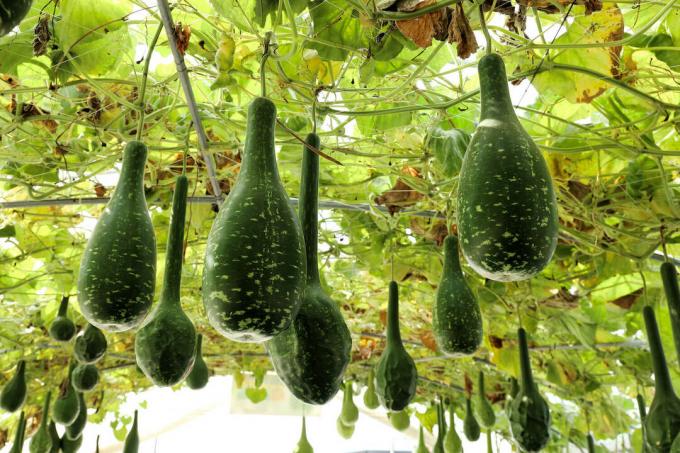
The Bottle Gourd (Lagenaria siceraria) owes its name to its characteristic bottle-like shape. Due to their special shape, the fruits not only offer a high ornamental value, but can also be used for many other purposes. We show what you can use the pumpkin for and how to cultivate it yourself.
Contents
- Bottle gourd: origin and properties
- The most beautiful bottle gourd varieties
- plant calabash
- care measures
- Harvesting bottle gourd: when and how?
- Is the bottle gourd edible?
- possible uses
Bottle gourd: origin and properties
"Calabash" is the middle name of the bottle gourd. This is based on the use of the dried gourd as a vessel, which is then called a gourd. The bottle gourd is one of the oldest cultivated plants and most likely originally comes from Africa. But it has also been found in America for around 10,000 years. The pumpkins probably made their way there by being washed over the sea. The bottle gourd is now at home in all tropical areas worldwide. If you want to grow the calabash in a moderate climate zone, it is rather difficult to meet its high location requirements. By choosing a suitable location, cultivation can also be successful in German-speaking countries - a very sheltered location or a place in the greenhouse is suitable for this. The representative of the pumpkin family (Cucurbitaceae) likes it extremely warm and completely sheltered from the wind.
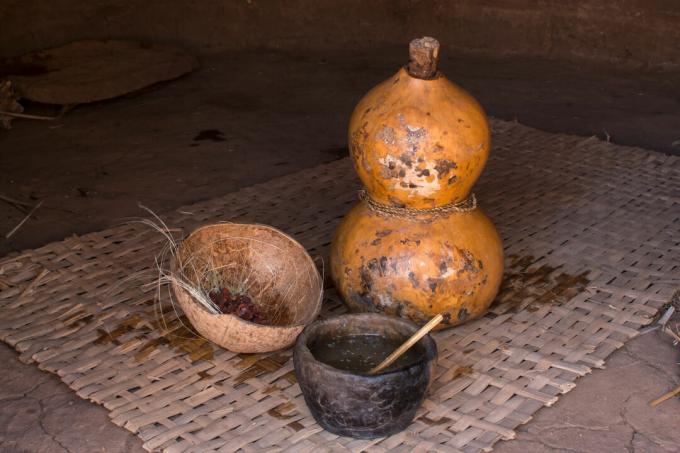
The climbing flat-root forms angular shoots that are often more than 10 m long and heart-shaped, hairy leaves. The plant emits a somewhat unpleasant odor through two secretion glands at the base of the leaf. Depending on the variety, large differences can be observed in the fruits. While some are only a few centimeters long, others reach a length of over 2 m. The unripe fruits usually have a delicate, hairy white or green skin that later becomes hard and smooth. When fully ripe, the squash skin is yellow, orange, brown, or green and often has a marbled pattern. During the flowering period from June to August, the annual bottle gourd forms white, bell-shaped flowers that only open in the evening or at night and can only be fertilized on one day. They are not pollinated by bees or bumblebees like other types of pumpkin, but by nocturnal insects. The bottle gourd flowers are monoecious. This means that a plant will have both male and female flowers. The latter have a thickened stem base. The large, brown seeds have longitudinal grooves. In the following we present particularly beautiful bottle gourd varieties.
Tip: Pollination of the calabash is not very reliable in a natural way due to the short time window. So it makes sense to pollinate by hand. Here, for example, the pollen of the male flower is applied to the stigma of the female flower using a brush.
The most beautiful bottle gourd varieties
- ‘Hercules Club Snake': Edible bottle gourd from southern Italy with bottle-shaped fruits up to 2 m long; Pulp can be prepared like pickles or zucchini.
- 'Mini Bottle': Small ornamental fruit with green fruits up to 15 cm long; climbing plant with attractive white flowers.
- 'Speckled Swan': Curved neck of fruit, reminiscent of a swan; green-yellow mottled skin; Can be eaten young or used as a container when dried and ripe.
- 'Wine lifter Kittenberger': Old variety from Styria; in the form of the fruit similar to a wine sap; edible fruits when young; dried to form a vessel or musical instrument.
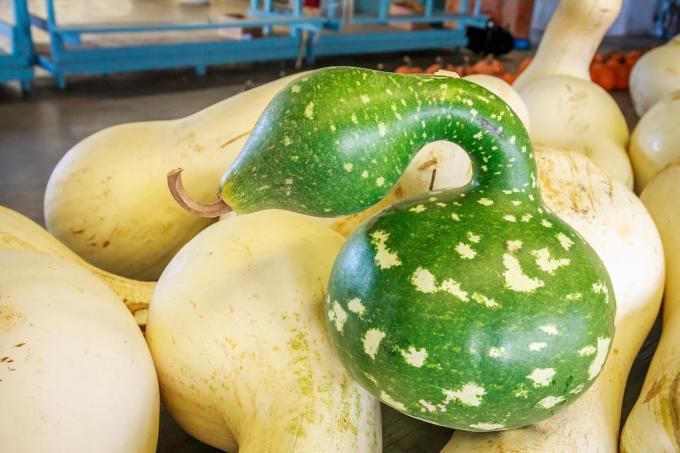
plant calabash
Due to its tropical origin, the gourd should definitely be preferred indoors - the bottle gourd seeds can be sown from March. Fill seed pots with a diameter of about 9 cm with soil. A nutrient-poor substrate like ours Plantura Organic Herb & Seed Soil is best suited as it stimulates the root growth of the plants. Then 2 seeds are placed 2 to 3 cm deep in a pot and carefully watered. To create a high level of humidity, you should stretch a transparent cover like foil over the potties. Take these off once a day to give dampening diseases no chance. Now the pots are placed in a bright place with 22 to 24 °C. A window sill is usually well suited for this. Be sure to stay hydrated for the next few days. After about 8 to 12 days, the seedlings should emerge. Then just leave the stronger seedling in the pot and place it in a slightly cooler place at 16 to 20 °C.
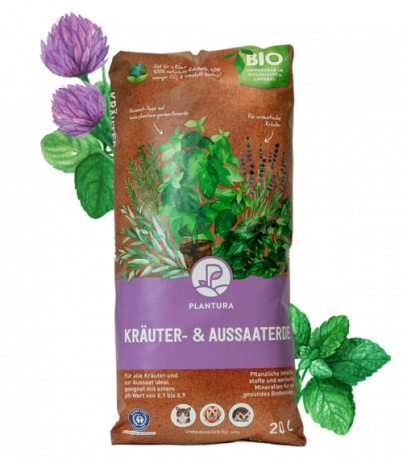
Organic Herb & Sowing Soil 20 L
- Ideal for herbs as well as for sowing, propagating cuttings and pricking out
- Ensures aromatic herbs & strong young plants with strong roots
- Peat-free & climate-friendly: CO2-reduced organic soil made in Germany
Due to its warmth-loving properties, the gourd should only be planted outside from the end of May. Hardening them off for a period of 1 to 2 weeks allows you to slowly acclimate the pumpkin seedlings to outdoor conditions. To do this, place them in a sheltered, semi-shady location during the day and return them indoors in the evening. Then you should look for a suitable place for the bottle gourd. A wind-protected, sunny place next to a fence is ideal, as the plant also has the opportunity to climb here. Because if you want to grow pumpkins in the classic bottle shape, the plant absolutely needs a trellis. If you don't have one yet, you can create one yourself Support for pumpkins build. Check out our separate article on how to do this. If the pumpkin is not given a chance to climb, the fruit develops in a rather ornate form.
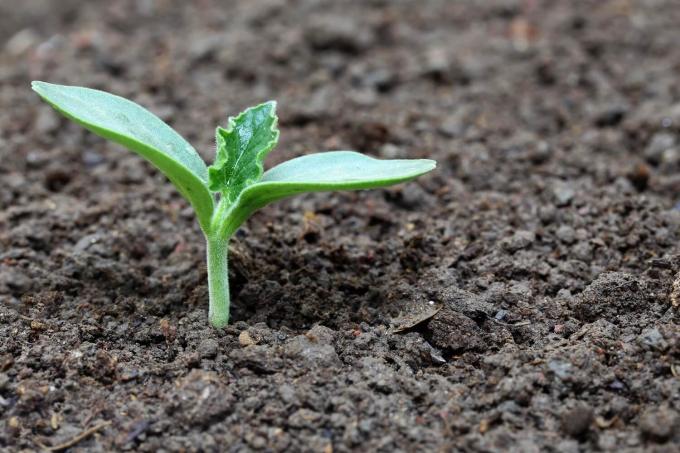
Since the bottle gourd is like all pumpkins (Cucurbita) is a heavy feeder, the substrate must be rich in nutrients. In addition, the soil should hold water, but not tend to waterlogging. A deep, medium-heavy soil such as sandy loam or loamy sand works well overall. Due to the high nutrient requirements, we recommend compost, stored manure or a nutrient-rich substrate like ours about a week before planting the small pumpkin plants Plantura organic compost to put under the ground. This is due to the high nutritional requirements of pumpkins or zucchini (Cucurbita pepo subsp. pepo convar. giromontiina) Voted.

Organic compost 62.5 L
- Ideal for all ornamental and useful plants with a high nutrient requirement and for raised beds
- For improved soil quality & healthy root growth
- Peat-free & climate-friendly: CO2-reduced organic soil made in Germany
Now dig planting holes for the pumpkin plants at a distance of 60 to 100 cm and then plant them. It should then be watered generously.
care measures
If a suitable location has been chosen for the calabash, the necessary care is limited. A good water supply and sufficient fertilizing are important. Note that the soil never dries out completely and the leaves are not wetted with water when watering. It also makes sense to water the plants early in the morning or in the evening to keep the evaporation of valuable water to a minimum. When fertilizing, in addition to stored manure or compost, a primarily organic long-term fertilizer like ours is used Plantura organic tomato fertilizer to recommend. This covers the increased potassium requirement of pumpkins and promotes soil life. Due to the long-term effect, two applications per year are normally sufficient. The first is ideally done before planting out and the second during the main growing season. Also make sure that the shoots grow well up the fence or the trellis and, if necessary, tie them with a non-cutting band. For anyone who would like to find out more details, we recommend our special article on Caring for pumpkins.
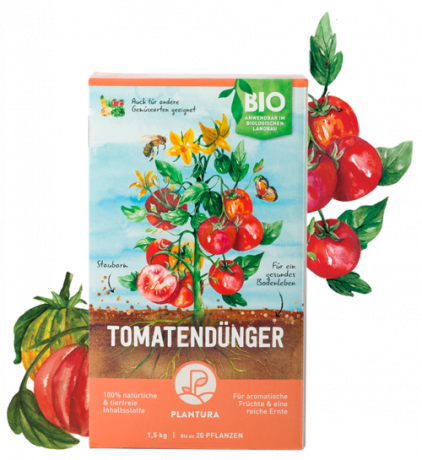
Organic tomato fertilizer 1.5 kg
- Ideal for tomatoes, chili, zucchini, cucumber & Co.
- For stronger plants & an aromatic, rich harvest
- Animal-free organic slow-release fertilizer - safe for pets and garden animals
Harvesting bottle gourd: when and how?
If you want to dry the bottle gourd, it must be fully ripe when harvested, otherwise it will rot. The harvest time is usually between September and October and the harvest must take place before the first frost. You can tell that the fruit is ripe by the following characteristics: the leaves are withered, the stalk has become lignified and a hollow sound is heard when the fruit is tapped. If everything applies, you can harvest the gourd. Using a sharp knife, cut the stalk off so that a few inches of it are still attached to the squash.
Is the bottle gourd edible?
The possibility of using gourds as vessels is known to many people. But did you know that they can also be eaten? Except for some ornamental gourd varieties, the unripe fruits of the gourd are used in a similar way to zucchini and the peel can be eaten. The pumpkin is not only healthy for us humans, but is also edible for dogs and cats. It is best to mix soft-boiled pumpkin with the usual food for four-legged friends. However, it should be noted that vegetables should only make up about 5% of the amount of food in a cat's diet. Be sure to consider that for us humans poisonous ornamental gourds are also toxic to dogs and cats.

possible uses
As already mentioned, the bottle gourd has a variety of uses. Drinking vessels and other vessels have been made from a dried and hollowed-out bottle gourd for thousands of years. You can also use a gourd for decorative purposes and paint it or make a lamp out of it. Musical instruments are also made from the fruit, such as the sound box of stringed instruments or rattles. In North America in particular, gourds are also used to build birdhouses. But for all these purposes, the gourd must first be preserved. To do this, the bottle gourd is dried in a warm and airy place. You should be patient though as the process can take up to a year. You can tell that the gourd is completely dry by the fact that the seeds inside rattle when you shake it. The fruit can then be carefully opened with a saw and processed further.

One of the most popular pumpkin varieties is the Hokkaido pumpkin (Cucurbita maxima). In our separate article you will learn everything about growing, harvesting and preparing Hokkaido pumpkins.
Secure a 10% welcome discount for our online shop and receive great tips, seasonal trends and inspiration from our garden experts every week.



